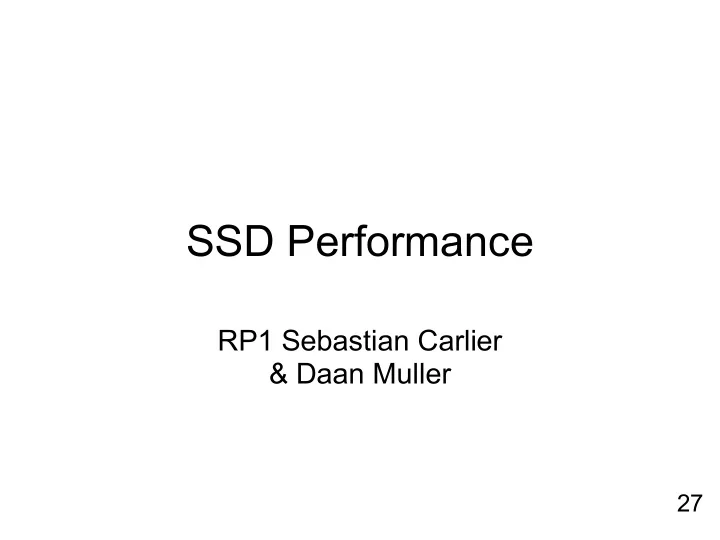

SSD Performance RP1 Sebastian Carlier & Daan Muller 27
Research topic Maximizing Solid State Disk throughput. Official research question: How can SARA implement S olid S tate D isks in their setups to improve sequential read performance over conventional spinning disks and what parameters should be used to accomplish this? 26
Testing parameters RAID stripe sizes File system block sizes RAID levels Software vs. hardware RAID Areca vs Dell RAID controller Number of disks (scalability) File systems 25
Server setup Base: Disks Intel Xeon CPU X5550 (Quad Spinning: core + HT) Dell 7.2k rpm 160 GB (x5) 6 GB DDR3 Solid state: Intel X25-M G2 160GB (x5) 8 disk SAS backplane SAS Controllers: Dell PERC 6/i Areca ARC1680xi-12 24
Intel X25-M G2 160 GB 10 x 16 GB Intel NAND chips multi level cell 512 KB block / min. overwrite size 4 KB page size / min. write size Manufacturer claims up to: 250 MB/s read speed 0.065 ms read latency 23
Predictions Read performance scaling linearly. Achieving higher read speeds with hardware RAID. RAID-0 / 1 arrays would be fastest in Linux. RAID-5 arrays would be a close second. Larger RAID stripe size would increase speed. Changing filesystem blocksize would have a significant effect. File systems having a noticeable effect. Predictions made during preliminary tests: Perc i6 RAID controller would be a bottleneck. Areca ARC 1680xi-12 would answer our prayers (that is reach ~1100MB/s read performance). 22
RAID levels RAID-0 RAID-1 RAID-10 RAID-5 RAID-6 21
RAID-0 20
RAID-1 19
RAID-0+1 18
RAID-5 17
RAID-6 16
File systems ext4 current Linux standard nilfs2 filesystem focused on recovery btrfs - 'butter FS' early version not fit for production use good scalability possible future standard on Linux zfs combining file system with disk array good scalability logfs/jffs2 designed for raw flash memory 15
ZFS: RAIDZ ZFS version of RAID-5 variable stripe size corresponds to file system block size only possible because of ZFS integration prevents partial-stripe write errors 14
Benchmark setup IOZone. Phoronix-test-suite used to automate testing. Sequential reads on an 8GB file. Every setup tested 3 times. Results rounded to MB/s 13
Testing file system blocksize single SSD file system ext4 file system block size: 1KB - 208 MB/s 4KB - 213 MB/s (default setting) Conclusion: file system block size is not a significant factor at these high read speeds. 12
5 SSD Hardware RAID-0. Controller does not handle a non-default stripe size efficiently. The 16KB stripe size generates too many operations. 11
SSDs no longer scale after 4 disks HDDs continue to scale after 5 disks 10
File system has a noticeable influence. 9
Dell controller handles SSDs better than Areca controller. 8 Software RAID beats hardware RAID.
Areca ARC 1680xi compatibility problems Intel IOP 348 CPU. Intel refuses to release source code. Areca cannot fix this problem themselves Many PCI-E SAS RAID cards use this CPU. Next Areca1880 series use a Marvell CPU Not available yet. Conclusion: Money well spent :) Wait for the ARC 1880 series or find a card with a different CPU. 7
RAIDz is faster while handling more disks than software RAID-0. 6
Proving the theory Where is the bottleneck for Linux ? Btrfs ? PCI-E 2.0 8x ? RAID Controller ? Connected 2 disks to Areca, 3 disks to PERC Software RAID-0 over 5 disks, btrfs 815 MB/s 5
Predictions revisited Read performance scaling linearly. Achieving higher read speeds with hardware RAID. RAID-0 / 1 arrays would be fastest on Linux. RAID-5 arrays would be a close second. Larger RAID stripe size would increase speed. Changing filesystem blocksize would have a significant effect. Filesystems having a noticeable effect. Predictions made during preliminary tests: Perc i6 RAID controller would be a bottleneck. Areca ARC 1680xi-12 would answer our prayers (that is reach ~1100MB/s read performance). 4
Conclusions Btrfs seems a valid solution for the future for Linux OS. "Ext4 is simply a stop-gap, Btrfs is the way forward." - Theodore Ts'o, ext4 developer RAID controller development is lagging behind. ZFS is the fastest solution available today. SSDs leave spinning disks behind. even when it comes to sequential reads. comparing them to consumer grade hardware. (FC / SAS ) 3
Further research The PCI-E v2.0 x8 bus has a 2GB/s throughput limit. Test a setup with a different RAID controller and 8 SSDs. Test a setup with multiple RAID controllers and 16 - 32 SSDs. PCI-E x16 RAID Controllers should hit the market in the near future. Test if 16 SSDs reach the theoretical 4 GB/s throughput. Test if a single system can stream enough data for an entire video wall. 2
Thanks ! For their expert opinions: Freek Dijkstra Ronald van der Pol Mark van de Sanden For lending us a RAID controller: www.WebConneXXion.com 1
Questions? 0
Recommend
More recommend